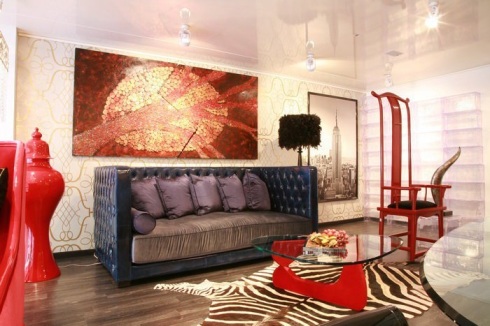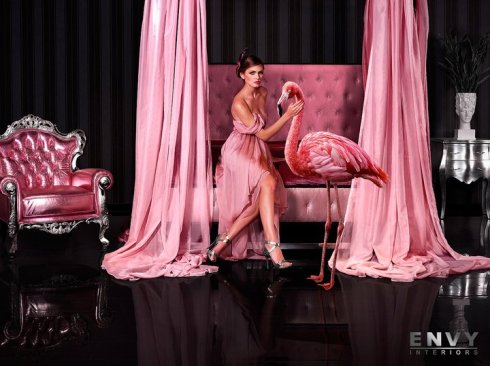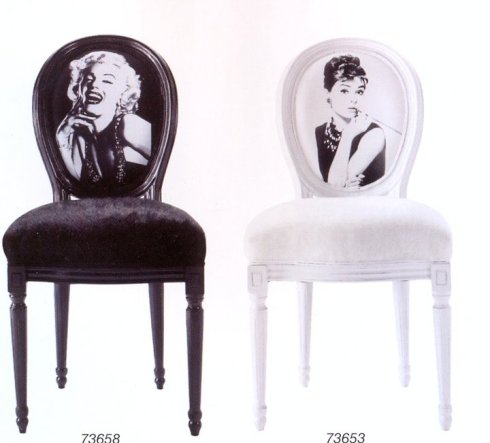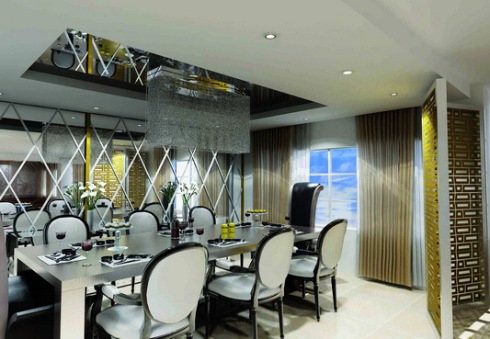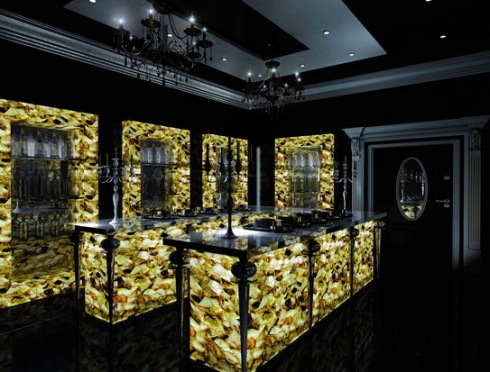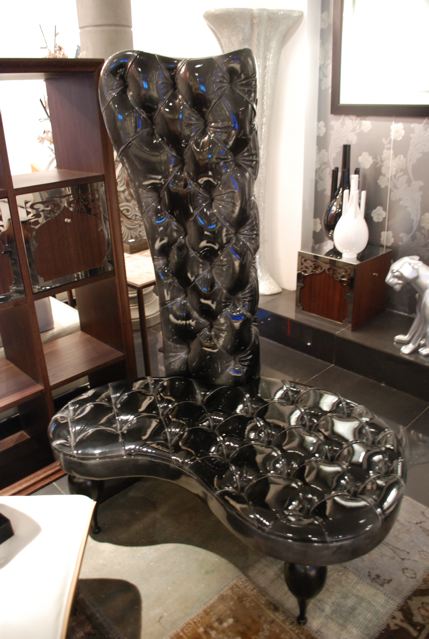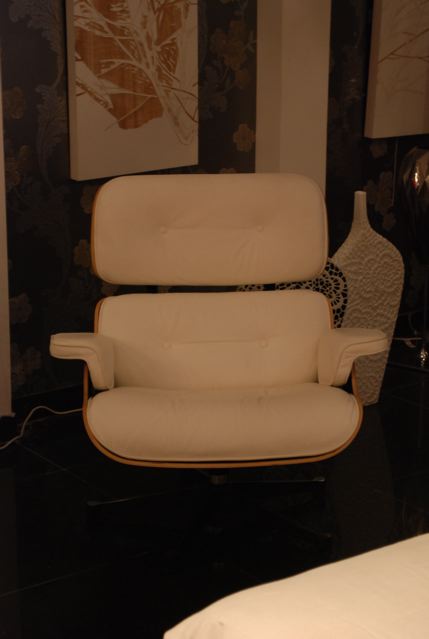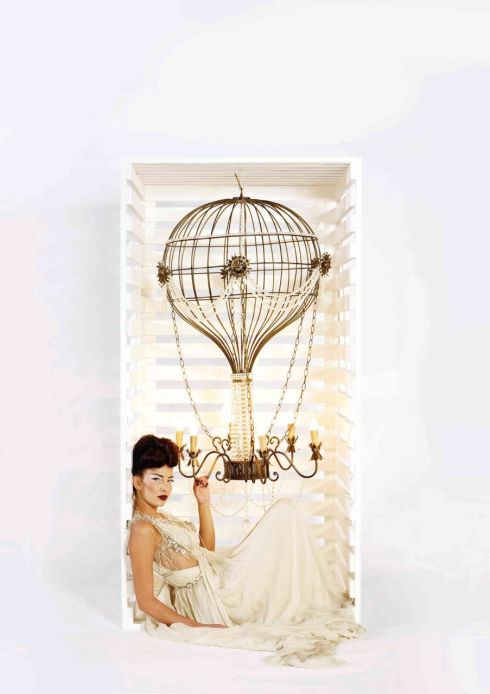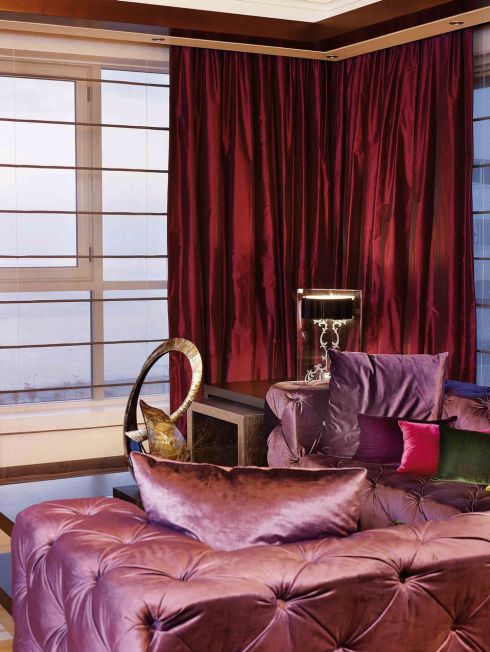Vick Vanlian Showreel
Royal sofa
16 MayRoyal sofa by envy Interiors
Lége Béton
To fully appreciate the potential of this unique composite material, you should hold a sample in your hands. Although it has the appearance and feels the ordinary concrete, Lége Béton is not nearly as heavy. Consisting mainly of concrete reinforced with synthetic fibers, it is used to make hollow forms in a wide variety of colors and textures. Suitable for furniture and range of interior design applications, the material is waterlight, waterproof and shockproof. The dye used to color objects made of Lége Béton throughout penetrates the material.
Visit our Website and join the following:
Facebook
Twitter
LinkedIn
Flickr
Home decorating tips by Vick Vanlian
13 AprHome decorating tips by Vick Vanlian

Vick Vanlian, Galerie Vanlian, Envy Interiors
Home Decorating Tip #1 – Define Your Scope & Goals
I know that you’d love to skip these decorating tips and begin decorating immediately, right? Well, I would encourage you to first print these home decorating tips for reference and then grab a pen and paper and jot down exactly what you want to accomplish.
This is done through a process known as scope and goal setting. It will add an amazing amount of clarity to your decision making once you get into implementing your interior decorating ideas.
For example, you might write, “Decorate the living room in a Traditional Style by December 31”. Go ahead, write down your scope. I’ll wait…
Next, list your goals beneath your scope. You may be thinking that the goal is simply, “To make the room look as beautiful as possible”. But you really should dig a level deeper.
Put answers to questions such as…
Will the project increase the value of your home? Is the project tied to an overall home improvement plan? Are you giving the room a partial or complete makeover? Are you redoing the room because you want it to handle additional activities? Are you creating your dream room or is this just a quick fix?
I could go on and on, but I think get the idea. Take your time and really make an effort to determine why you’re doing the home decorating project and what you hope to achieve. It’s critical that you complete this step before moving to the other home decorating tips.
Home Decorating Tip #2 – Define Your Budget
Let’s keep the momentum going. By the way, did you print these decorating tips for your files? Just checking 🙂
Next, you should establish a budget for your project. How much will it cost to turn your home interior decorating ideas into reality? To create your budget, list the cost of materials, services, building permits, etc., in as much detail as possible.
Use the merchants mentioned on this web site to get a feel for the prices of furniture and furnishings. Contact craftsmen in your area for the cost of services such as painting, plumbing, and electrical work. I’ve created a Home Interior Design – Budget Worksheet to help you.
Once you arrive at your total, add 10%-20% as a contingency to cover unexpected costs.
Considering your scope and goals…
Can you live with the final dollar amount? If not, you’ll have to decide what changes to make.
As you progress in your decorating project, it is important that you frequently compare your budget against your actual spending. It would not be unusual for your goals to change in mid-stream, but this way there won’t be any financial surprises.
Home Decorating Tip #3 – Find Your Decorating Style
I could write pages and pages about all the historic and modern decorating styles and what makes one different from another. But what ultimately matters is that you seek out and learn more about your own decorating attitude. Why?
Because knowing your decorating attitude will make it easier to identify furniture and furnishing that will fit well together and will work for you.
In keeping with the intent of this web site to provide concise information, I’ve devised a quick and fun quiz to help you identify your decorating style. Is it Traditional, Casual, Contemporary, or Eclectic?
Traditional – Your furniture and furnishing are comforting and classic. There may be a mix of old world styles such as Queen Anne, 18th Century Chippendale, Hepplewhite, and Sheraton. Your colors are typically soft and you are undoubtedly a lover of antiques.
This basic list of Traditional Decorating ideas should help to enhance your understanding of this style.
If you want to further expand your knowledge of Traditional decorating and get many more home decorating tips and insights, check out the book… Signature Style.
Casual – You prefer your home to be simple and warm. Your upholstery is soft and round, and fabrics are usually in earthy or neutral colors.
Seating is arranged informally and everyone immediately feels as though they can plop down anywhere. Accessories are lighthearted and whimsical.
Review this list of ideas to put you in a Casual Decorating mindset.
To learn more about Casual decorating read… The Family Home: Relaxed, Informal Living For All Ages
Contemporary – You prefer a sleek, sophisticated design with clean lines. Accessories are minimal, but what you have could be described as elegant simplicity. Some may consider your home to be cold and stark. There may be lots of glass and stainless steel.
Your choice in colors may range from black and white to bold and vivid.
Click on this link to Contemporary Decorating ideas to jumpstart your thinking.
For more Contemporary decorating ideas, I recommend Contemporary Decorating: New Looks For Modern Living
Eclectic – Your style is a mix of two or more of the above styles. You occasionally rebel against conventional design rules. I would also describe my own decorating attitude as Eclectic.
Take a peek at the Eclectic Decorating in my home for ideas.
You can get the scoop on more decorating styles and how to mix them effectively by reading our ebook Awaken Your Interior Designer
Home Decorating Tip #4 – Lay Out Your Floor Plan
You’re developing quite a project plan aren’t you? Can you see the big picture starting to come together? Great! I’m glad these home decorating tips are helping.
The next step is to lay out the floor plan for each area to be decorated. Using a pencil and graph paper, make a drawing that represents the length and width of the design space. Be sure to indicate the location of windows, doors, and other architectural elements.
Make several copies of the floor plan because later you’ll use them to help determine the best way to arrange your furniture. You’ll actually draw little shapes to represent your chairs, sofa, tables, bed, etc.
Home Decorating Tip #5 – Identify Your Focal Points
A focal point gives the eye an initial point of interest so that it can begin to take in the interior landscape of a room with ease. It can be an eye-catching architectural element such as a fireplace, large bay windows, or built-in book shelves.
Envy Interiors Photo Shoot 2011
12 AprEnvy Interiors Photo Shoot 2011
Effective Ways To Use Home Lighting In
Interior Decorating
Home lighting is arguably the most important element in home interior decorating. It is instrumental in setting the mood of any room.
To ensure that you will achieve the desired effect for your rooms, it is important that you first understand the four basic types of home lighting.
1. Ambient or general lighting – illuminates the whole room. You probably notice it from recessed and track lighting. Certain wall sconces are yet another example. I recommend that you install a dimmer with your track and recessed lights so that you have the added flexibility in adjusting the brightness.
2. Task lighting – provides sufficient light to help you perform the task at hand, e.g., reading, cooking, shaving, etc. Task lighting should be glare free. And it should make things easy to see without tiring or straining your eyes.
3. Accent lighting – is focused lighting that is used to illuminate a sculpture, piece of art, or architectural element in a room. Accent lighting is about three times as bright as ambient lighting.
4. Natural lighting – comes through windows, doors, and skylights. Depending on the time of day, season, or weather, it can vary in brightness and intensity.
Visit our Website and join the following:
Facebook
Twitter
LinkedIn
Flickr
Vintage Furniture by Galerie Vanlian!
11 AprVintage Furniture by Galerie Vanlian!
Arranging Your Furniture
Arranging furniture is somewhat of an art and therefore it must incorporate your personal preferences and style to achieve the mood you want. You have many options, so it is very important that you layout your living room decorating ideas with pencil and paper first.
Let your imagination and creativity flow, but keep the following in mind:
- Identify walkways through the room and keep the paths clear
- Break up a large room into two or more activity areas
- Don’t fall into the trap of thinking that all major pieces must have their backs against a wall
- Don’t block windows and doors to the point of making it difficult to open and close them
- Be sure that a table is beside or near each seat in the conversation area
- Ensure that chairs are no more than three to four feet apart within a conversation area
- Don’t feel you have to find a place for every piece of furniture you own…avoid a cluttered look
The starting point for arranging your living room furniture is around the focal point. Configure a conversation area so that the eye will naturally flow to it.
If, for example, your focal point is a large window with a great view, try arranging your chairs, sofa, and desk to take advantage of the scenery.
You’d be surprised that by simply shifting your furniture a few degrees, your room will take on a look that you never imagined.
If by chance you have a room with competing focal points such as a piano and fireplace, you will likely have to choose one over the other.
This is especially true if you have a small living room. However, if the room is very large you should move the piano to the opposite end and create a second conversation area around it.
Once you have your conversation area and focal point aligned, start filling in the rest of the room. Identify an area for each activity on your list and then place the appropriate furniture and furnishings there.
Take a look at my Eclectic living room below…
This room is rectangular in shape with dimensions of 14 X 20 feet. The sofa is angled across a somewhat narrow room to make it look wider. A 8.5 ft. Ficus tree, sofa table and armoire help to make the conversation area cozy and inviting.
Of course, if you’re like many people and want a more hands on approach to help you get started with your decorating, then I suggest you check out The Awaken Your Interior Designer! Collection.
In addition to providing lots of great living room decorating ideas, the eBooks walk you step-by-step through the decorating process. You’ll get the insights you need to decorate or redecorate your living room with confidence.
Visit our website or join us on:
Wonderful dining rooms by Envy Interiors!
8 AprWonderful dining rooms by Envy Interiors!
Arranging Your Furniture
Arranging furniture is somewhat of an art and therefore it must incorporate your personal preferences and style to achieve the mood you want. You have many options, so it is very important that you layout your living room decorating ideas with pencil and paper first.
Let your imagination and creativity flow, but keep the following in mind:
- Identify walkways through the room and keep the paths clear
- Break up a large room into two or more activity areas
- Don’t fall into the trap of thinking that all major pieces must have their backs against a wall
- Don’t block windows and doors to the point of making it difficult to open and close them
- Be sure that a table is beside or near each seat in the conversation area
- Ensure that chairs are no more than three to four feet apart within a conversation area
- Don’t feel you have to find a place for every piece of furniture you own…avoid a cluttered look
The starting point for arranging your living room furniture is around the focal point. Configure a conversation area so that the eye will naturally flow to it.
If, for example, your focal point is a large window with a great view, try arranging your chairs, sofa, and desk to take advantage of the scenery.
You’d be surprised that by simply shifting your furniture a few degrees, your room will take on a look that you never imagined.
If by chance you have a room with competing focal points such as a piano and fireplace, you will likely have to choose one over the other.
This is especially true if you have a small living room. However, if the room is very large you should move the piano to the opposite end and create a second conversation area around it.
Once you have your conversation area and focal point aligned, start filling in the rest of the room. Identify an area for each activity on your list and then place the appropriate furniture and furnishings there.
Take a look at my Eclectic living room below…
This room is rectangular in shape with dimensions of 14 X 20 feet. The sofa is angled across a somewhat narrow room to make it look wider. A 8.5 ft. Ficus tree, sofa table and armoire help to make the conversation area cozy and inviting.
Of course, if you’re like many people and want a more hands on approach to help you get started with your decorating, then I suggest you check out The Awaken Your Interior Designer! Collection.
In addition to providing lots of great living room decorating ideas, the eBooks walk you step-by-step through the decorating process. You’ll get the insights you need to decorate or redecorate your living room with confidence.
Visit our Website and join the following:
Facebook
Twitter
LinkedIn
Flickr
Wonderful chairs by Envy Interiors!
29 MarWonderful chairs by Envy Interiors!
Interior Decorating
IN the rudest attempts to provide homes we find evidence of a desire to decorate them.
In early examples ornament usually springs out of constructive methods; others are merely surface additions, but either symbolical or purely decorative (as in the curved forms and interlacings).
However, practically in every style of ornament that we can study we find in the early types some reminiscences of constructural details.
Thus the Egyptian column (like that of Chaldea) is a tree trunk, or a bundle of reeds, ornamented with flowers; their dado, though carved in stone or painted on stucco, is the representation of a reed mat, of wattle looped together with flowering water plants.
In Greek marble buildings we discover the ends of the long-discarded timber joists peeping out below the beautifully proportioned, carefully carved entablature; consoles and brackets belong to the log era.
Heavy Brahminical stone buildings, even the cave temples, retain features that are peculiar to timber practice.
In the same way most of the early surface ornamentation is symbolical, though springing from familiar objects turned to decorative ends.
Egyptian architecture and ornament may be classed as entirely symbolical, for there was a meaning in the pylons and obelisks, the hybrid animal forms, the lotus, papyrus, palm, and other botanical motifs.
Greek ornament, though in its primitive types symbolical, was not so in the main; nor was it in the Roman, though embracing many symbols.
Early Christian art was essentially symbolical. Churches were cruciform or circular. Ornament, when not cruciform, was a little more recondite – circular, triangular, trilobed or represented fish, ships, lambs, peacocks, doves and pelicans, eagles, winged bulls and lions, and many other things.
Even colour has its devotional and ritual significance.
Although this side of the problem is not fundamentally important to good design, it is imperative that ornament should be appropriate to that which it is to embellish and all its surroundings.
So that selection, both as to quality and quantity, the latter involving questions of balance and general design, is necessary.
We shall easily understand this if we consider the objects we have in view.
We will let one who was not unsuccessful in his profession speak.
Sir William Chambers says: “Ornaments are to be chosen or rejected according to the associations which exist between their adoption and the effects which they are calculated to produce on the mind.
When we aim at an effect of grandeur and stability, but few ornaments are admissible, because many subdivisions of the detail, which is the case where decoration is unsparingly used, destroy the ideas of strength, as, in fact, they weaken, or appear to weaken, the parts whereon they are employed.
Hence, according to its destination, ornament and variety therein must be more or less introduced into the work, always bearing in mind that excess and overloading, when ornament is profuse, distract and fatigue the eye and tend to destroy the effect of the best-arranged design.”
Thus we see that, quite apart from the question of symbolism, tradition cannot be ignored.
As Sir Frank Warner well said: “The question of styles is an all- important one, and will probably remain so as long as the world lasts.
Archaeology is, therefore, of vital necessity to all who are engaged in the trades of building, decoration, and furniture,” and, he might have added, to all those who wish to appreciate past efforts and enjoy intelligently the works of the present.
Visit our Website and join the following:
Facebook
Twitter
LinkedIn
Flickr
Royalty by Galerie Vanlian!
28 MarRoyalty by Galerie Vanlian!
Express Your True Nature with Earthy Green
Ripe Avocado Green
Blocks of vivid avocado green brighten this sun-drenched dining room, creating a welcoming spot for meals. Natural light brings out the warmer tones from the yellow end of the green spectrum found in this cheerful color choice. Wide swaths of white trim keep the green color pure and potent.
Your color personality: Loyal and involved
Mellow Jade Green
Walls and ceiling bathed in luscious jade green blend this lakeside retreat’s living room into the natural surroundings outside its ample windows. Green has the easygoing ability to mingle with all colors of the spectrum, which makes it a perfect choice as background for a room with colorful furnishings as seen here.
Your color personality: Balanced and reassuring
Charming Apple Green
Vibrant toile in an unexpected combo of apple green and red covers beds, coverlets, and draperies to set the color palette for this charming bedroom. As the color of hope and renewal, green is the perfect choice for an invigorating private retreat such as a bedroom. Additional accents in green and complementary red along with crisp white trim keep the vivid toile from overpowering the space.
Your color personality: Serene and precise
Pure Celery Green
Green-painted walls visually expand the small dimensions of this updated cottage-style living room. Fabrics in bold-green-and-white prints transform classic furniture styles into pieces with modern flair while white slipcovers and accents add cottage freshness to the simple color scheme. Small pops of orange punctuate the room with panache.
Your color personality: Self-possessed and fair
Fresh Pistachio Green
Green is the ideal color for an open-plan house because multiple tones blend easily. These pistachio-green kitchen cabinets are visible from most rooms of the main floor, yet they bathe the room in color without overwhelming adjacent spaces. Vertical taupe-painted paneling provides continuity. Cornflower-blue plate racks mix with the fresh green color to exude a joyful mood.
Your color personality: Principled and open-minded
Neutral Celadon Green
Soft green paint creates a natural, neutral background like a quiet meadow in this open-plan condo. Rich brown upholstery unifies an assortment of hand-me-down furnishings and reinforces the natural mood. The neutrality of greens and browns allows a plethora of patterns and colors to mix freely in the open space.
Your color personality: Stable and visionary
Visit our website or join us on:
Small Design Changes, Big Impact!! by Vick Vanlian!!
23 MarSmall Design Changes, Big Impact!! by Vick Vanlian!!
Five Easy Ways to Freshen Up Your Home for Less
True, we’re all living more cost-consciously these days — we’re dining out less, forgoing luxuries like vacations and new wardrobes, and we’re spending less on furniture, too.
The January 2008 issue of “Furniture Today” projected a mere 0.4 percent increase in furniture sales over the course of the year. The good news is that it doesn’t take much to turn your current decor into something completely fresh and different. There are plenty of easy, cost-effective ways to change your surroundings for the better.
“Sometimes the smallest changes can make a big difference in the look of your home. One of the first things I recommend is visiting a nearby professional custom framer and updating an existing piece of art with new matboards,” says Barbara Schmidt, a nationally recognized interior style consultant whose work has appeared in O at Home, This Old House and Renovation Style, and numerous television shows.
“Look for a new color to add focus to your art pieces,” says Schmidt. “And when choosing matboard for your artwork, make sure it’s made from high quality materials, like Crescent’s cotton RagMat matboards. RagMat is guaranteed safe next to any artwork for a lifetime.”
Schmidt offers four additional tips for freshening up any room in your home using inexpensive items, as well as preexisting pieces.
* “Choose one new color for your room and pull it into slipcovers, rugs and tablecloths to create newness and cohesiveness,” Schmidt suggests. “Try spray-painting a lampshade as an inexpensive way to tie it all together.”
* Dress up a wall by adding a tight grouping of your favorite pictures. “Pull your chosen color into the matting and frames, but vary the width and style of the frames to add variety,” she says. “This is definitely a growing design trend — and it’s a great way to make use of family photos and other images you’ve always wanted to display.” Your local professional custom framer can help you create this look.
* “You’d be surprised at how easy it is to make pillow covers on your own,” says Schmidt. “Or you can opt to buy them pre-made at fabric stores for a lot less than you’ll find at a big-box retailer. It’s possible to find beautiful colors and patterns at bargain prices. You just need to do your research.”
* “Choose one wall in a room, and repaint it to change the color scheme,” says Schmidt. “Painting is one of the most inexpensive things you can do, and I guarantee the entire room will look brand new.”
Beyond making unnecessarily large purchases, our shift in financial priorities is having a more lasting impression on the way homes are decorated. Consumers are moving away from the “ready to wear” mentality that became popular with the recent rash of design-centered reality shows in favor of more permanent pieces.
“More than ever before, my clients want pieces and themes that are going to last,” says Schmidt. “When it comes to big ticket items like tables and sofas, I advise them to choose timeless looks with clean, sleek shapes. That way, when they do want a change in the look and feel of a particular room, they can just make small tweaks to turn it all around.”
A Lebanese Interior Designer.
Join me:
Regards,
Vick Vanlian.
Distinguish mugs in addition to tips for an organized kitchen!!by Envy Interiors!
22 MarDistinguish mugs by Envy Interiors!
Tips for an organized kitchen by Envy Interiors!!
If you’ve read some of my earlier posts, you know that I am eagerly looking forward to renovating my kitchen. Right now, there really isn’t much about it that works for me, but storage has become a particularly big issue lately. I’m so tired of having things fall out of the cabinets every time I open them and of having to run down to the basement every time I need as pot. I’m sure I’m not the only one with kitchen organization issues, which is why these tips for an organized kitchen from IKEA are bound to come in pretty handy.
- Starting with the initial kitchen plan consider the functional “triangle” consisting of the sink, stove and refrigerator for cleaning, prepping and cooking. Keep the three areas close enough for easy movement to each location, with adequate counter space in between for work areas.
- Organize the kitchen by “work stations”, just like restaurants do. Establish stations for prepping, cooking, baking and cleaning. Store related items as close as possible.
- Place seasonal or infrequently used items in overhead cabinets that are harder to access. If space is at a premium, consider storing these items outside of the kitchen in areas like a garage or basement. Use shelving units which maximize available height.
- Kitchen islands are a great way to add extra work space. Even a small kitchen can benefit by adding a portable island at the end of a counter. Use the space underneath to store extra pots and pans or hold a recycling container.
- Be safe! Keep heavier items on lower shelves where they won’t create a hazard when removed.
- Place cooking oils in cabinets located away from the heat of the stove to keep them from spoiling.
- To quickly find staples such as sugar and flour, store them in drawers at waist level, rather than in overhead cabinets. It’s much easier to view the contents by looking down at them, rather than pulling items out and looking behind them.
- Use adjustable drawer dividers and specialized storage containers to personalize kitchen storage. Consider the types of food most often prepared and customize as needed.
Visit our Website and join the following:
Facebook
Twitter
LinkedIn
Flickr
